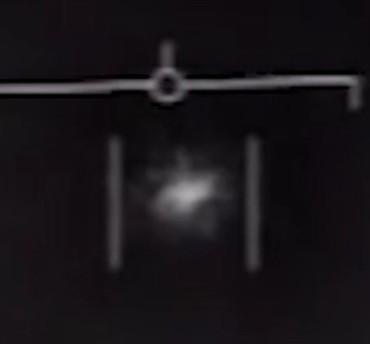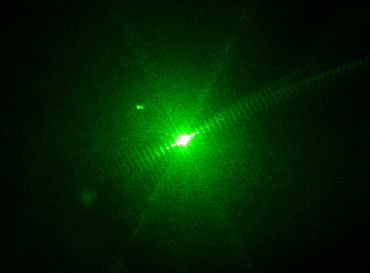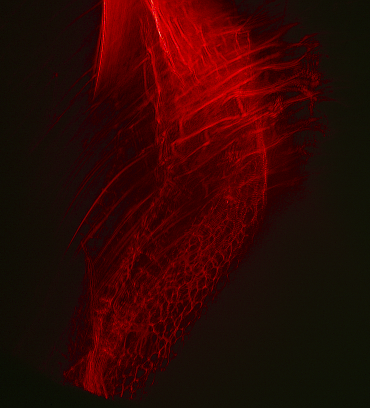 he news media are still professing bafflement about that Tic Tac that US Navy
F/A-18 Super Hornet fighters contacted way back in 2004. It's become as famous
as that
he news media are still professing bafflement about that Tic Tac that US Navy
F/A-18 Super Hornet fighters contacted way back in 2004. It's become as famous
as that flying saucer weather balloon that was found in 1947.
But I am convinced that what the recordings show is (a) not an object, (b) not flying, and (c) not unidentified. Which rules out UFO on all three counts.

FLIR image of Tic-Tac (screen grab from video)
At right is a screen grab of one frame of the supposed UFO. Notice that it's a bit jagged around the edges. This is not noise: the exact same pattern appears in every frame. It's possible, of course, that this could be caused by some camera defect, such as a drop of schmutz covering the lens, but I've experimented with cameras and lasers for years; to me it looks like a classic laser interference pattern.

Green laser interference pattern

Green laser interference pattern

Red laser interference pattern
At right are some laser interference patterns I photographed in 2013. These are made by pointing a green laser pointer through a refractive object, which distorts the beam, just as propagating a laser through the atmosphere would do, and photographing the image that appears on the wall. A wide variety of patterns is possible, and sometimes they can be quite beautiful, but the important point is that these patterns are static, just like the pattern in the Navy's infrared camera.
The giveaway is the radar contact which they picked up on passive AN/SPY-1B radar. The pilot, Chad Underwood, said “We're not necessarily looking for something, but the Princeton had a specific object that they wanted us to hunt, for lack of a better word. And all of a sudden, I got this blip on my radar.”
He also says “The Tic Tac was . . . going from like 50,000 feet to, you know, a hundred feet in like seconds, which is not possible. . . it wasn't behaving within the normal laws of physics.“
Everyone who's familiar with microwaves knows that a radar return, even a signal in a passive radar, cannot be trusted. It's common practice to jam radar by sending out false signals. These signals are designed to make the receiver think the object they're tracking is in a different location or flying at a different speed. This makes it more difficult for an enemy missile to lock on to the real target.
Radar jamming has long passed the age where blasting broadband noise at the attacker has much of an effect. Nowadays, a computer records the incoming wavetrain, analyzes it, and re-transmits a different one to simulate a Doppler-shifted target. It can transmit fake pulse trains designed to mimic a plane where none exists and conceal one that does exist. And it can easily fake an object traveling at unphysical velocities.
The technology for doing this has been in use for decades, and so it's something of a surprise that UFO enthusiasts still report ‘impossible’ radar tracks as evidence that they must represent an impossible object, i.e. an extraterrestrial craft. This is simply not the case.
When Underwood says the blip suddenly showed up, as if somebody turned on a switch, this is what is happening: the false signal was activated. Somebody turned on a switch.
Now, I'm sure some people are asking “Why in the world would aliens from another planet be sending out fake radar signals and beaming infrared lasers at our fighter aircraft?”
But what's interesting is that the radar signals would exhibit behavior that is unphysical for a real aircraft. This indicates that in 2004, the Navy's jamming technology was not as advanced as it is today. Enemy missiles today are programmed to ignore signals that appear fake. They use, for the most part, pulsed Doppler radar, which is still the easiest way to get accurate distance and velocity. If the apparent velocity is wrong for the target, or if its polarization and intensity are wrong, the computer in the missile would generally be programmed to classify it as a false signal.
As for lasers, there are two types of infrared seekers. The old type had a single point sensor with rotating optics that was connected to a control circuit. When the infrared signal (from the target's exhaust) goes off-center, the missile changes course to re-center it. The standard way of jamming these sensors is by ejecting flares or using infrared lasers that trick the sensor into veering the missile off-course.
The newer way of tracking a target is to use imaging infrared sensors, as we see in the F/A-18A video. How do you jam a camera? The classic way is to dazzle it. Burning out a sensor this way isn't easy, because IR cameras reduce their gain automatically—you'd need a high-powered laser. Chinese researchers have published many techniques in the open literature for subtracting out the dazzling signal. The PLA has also published numerous research articles on different ways to make laser dazzling more effective. One paper talks about using a pulsed laser. The pulsing rate is optimized to confuse the camera, which has a delay before it can restore its original gain, while minimizing the laser power. (If the power is too high, it makes the jammer vulnerable to home-on-jam techniques.)
Why would the pilots talk about these things as if they think they're real UFOs? Maybe they're not being trained in the technical aspects of the radar and IR sensors on which their lives depend. But more likely is that they're told to call them UFOs.
It seems obvious, then, that this Tic Tac incident was a test to see how well a laser jamming signal could be coordinated with radar jamming. From the comments that the pilots released to the press, it appears that it works very well indeed. And that may be why The Navy released it: they want our adversaries to know their missiles can and will be jammed.
I emphasize that none of this is classified information. I have no access to anything secret, nor would I reveal anything secret if I did. All this information is in the public literature, if only we could convince the press to read it. (Some reading suggestions are in the right column.) The press may be fooled, but the PLA understands its significance.
If I were The Navy, I'd be spending my billions on cloaking technology instead of mucking about with laser jamming. And I suspect that's what they're doing. We just haven't seen it, possibly because it's invisible.
I would love to see evidence of a flying craft made by aliens from outer space, but this ain't it.
dec 20 2019, 6:35 am. edited 7:27 am
